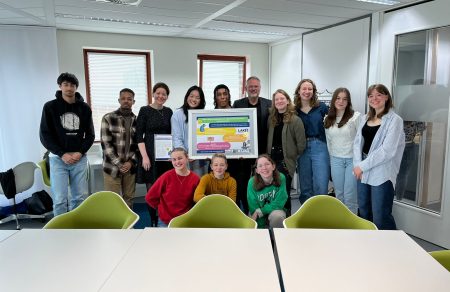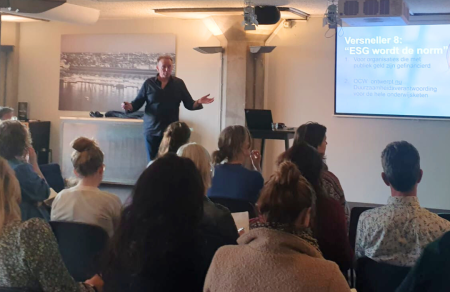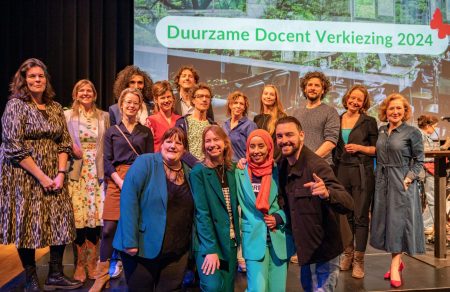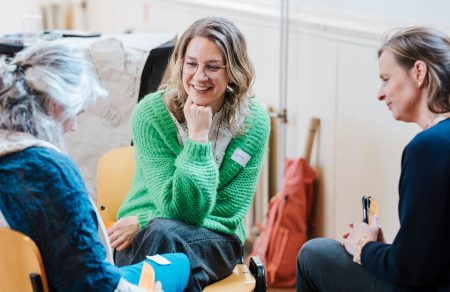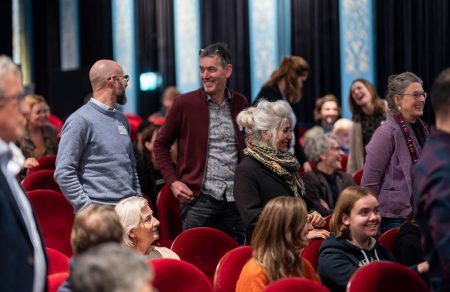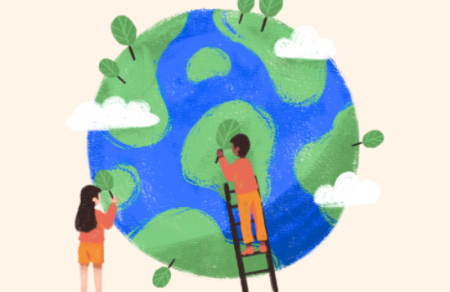What this book is about
The foreword - by the president of NVON - states, "This book brings the didactic foundation with which teachers can go on the road". However, it seems to me to be about much more. For the first six chapters articulate such cores as: sustainability task, uncertainty of knowledge, learning and development process of the teacher himself, leather by students and the pedagogy associated with it, and coherence between subjects.
However, the book provides further guidance on how to arrive at a responsible approach to sustainability issues. For example, Chapter 7 discusses the complex issues of systems thinking, the collaboration with third parties (fellow teachers and external institutions) and the designs of lessons and complete lesson series by teacher development teams (called DOTs in the book). And in Chapter 8, the authors take us through the Whole School Approach, probably a method that is gradually becoming somewhat more familiar in educational and educational (NME) circles. Finally, in chapter 9, to conclude with the need for another human view, principles of change processes and focusing on the 'outside world' (such as lectures/seminars, advice to the House of Representatives, continuing education and research proposals). The NVON itself is not forgotten either: "Form a working group within NVON with lines to all active groups in the association and supported by the board".
The initiators certainly did not "walk overnight. The editor of the book already consists of about six people while the number of (co-)authors is 16. A large number of illustrations: photographs by Sia Windig; tables, graphs and other images by Horst Wolter; they are generally clarifying to the text. Together, these have produced a study and reference work on teaching and learning in relation to sustainable development that may well be called "monumental.
The NVON itself provides a description of the book on its website (see here); part of which reads: "Climate change, disappearance of biodiversity, increasing pollution, depletion of natural resources....the global society is struggling with a multitude of crises, which are also mutually reinforcing. We can turn the tide by rapidly making our lives more sustainable. Herein also lies an important task for education, especially from the science subjects. How do you shape sustainability within a school?
Plan Beta provides a vision and tools for science teachers and school leaders to bring focus and pace to the move toward sustainable science subjects within a sustainable school .......
Plan Beta challenges science teachers and school leaders to do more with sustainability, increase the pace of sustainable development, and make a difference for their students. Plan Beta also aims to start a movement in which science teachers support each other in designing teaching materials, in implementing and evaluating sustainable education, in organizing the whole school around the theme of sustainability. The movement includes teacher training and further education and carries the activities and results to society".
Essence in outline
But there is more to be said about it. With its chosen format, it rises - at least, in the thorough preparation of the teacher as well as in the substantively "cross-curricular" approach - above an earlier work of the NVON, "Ecology Learning & Teaching; see here).
At the review of that book (see here), I asked one of the authors whether the ecological topics covered could not be placed more strongly in a social context (to increase applicability and relevance for students). To which the answer came that - at least in that book - that was precisely not was the intention. Let the students first understand what ecology is, they must have thought. And there is something to be said for that. Plan Beta seems to be the sequel to that, and so it does.
A feature of this new book is that it takes the reader primarily through that extended, self-development process that the authors have in mind; referred to above as "teacher preparation. This means that relatively little attention has been given to a direct approach in the classroom (or beyond); it is not a manual for forms of work in teaching practice.
For such concreteness, the reader is better off - at least if one looks for such information in books - going to others that deal with education and sustainability, such as "Teaching about Sustainable Development" by Martin de Wolf et al. (see here). The review on that is here find. By the way, it would not have been out of place if that book had been included in the bibliography.
Other sources may be, for example; as well as Stan Frijters' 2016 booklet, 'Learning for Sustainable Development. Just Do It'. See here.
The most important feature of this book seems to me to be the search of the editors and authors for connection beyond their own field, multiperspective, in other words. That search for context for "STEM sustainability phenomena" and teacher preparation for it are, to me, central to this book. Only, curiously, the word "context" appears in the register not for it. Well, fortunately, "systems thinking.
The above is well reflected in Chapter 6 ("Coherence from Subjects") where the contributions of different subjects to thinking about and understanding sustainable development are elaborated. The following subjects are covered: mathematics, physics, chemistry, biology, R&D and NLT, geography, economics and Dutch.
This is a great achievement because it provides teachers and developers of teaching materials with many starting points for lesson design. However, it is then again not easy to understand that, although throughout the book the social context of sustainable development is in fact central, this same elaboration is not described for the subject of social studies (undergraduate havo: man and society) and - including: (global) citizenship education.
It seems, therefore, that the authors consider the concept of systems thinking to be primarily an insight that emerges within (or on the edge, such as economics) of the STEM subjects manifests itself. While human action takes place within a multitude of very different 'domains/systems'. And this precisely involves the whole range of gamma (and alpha) subjects.
A practical example is the cultivation of, say, coffee bushes in low-wage countries and the consumption of coffee in a country like the Netherlands. After all, between cultivation and consumption all kinds of 'systems' play a role that must be attuned to each other, such as: agro-ecological (cultivation), socio-economic (income for the farmer), technical (roasting of the beans), macro-economic (trade, ex- and import regulations), energetic (transport), geopolitical (global power relations), psychological (purchase by consumer).
A much more profound argument for that socialization gives the book itself: the necessary changes to the type of society in which we live. The authors state (pp. 263/264): "How can science teachers contribute to building a worldview in their students focused on humanity, care for each other, for other species, and for a just society , in short in the development of a responsible citizen?". It would therefore have been logical if connections had been made here with the work of, for example, Annick de Witt (see here) and Dorine van Norren (see for example). De Witt discusses how a person's worldview so determines their own thinking and actions. Van Norren shows how non-Western worldviews, such as Ubuntu and Buen vivir can make sense in practice.
'Social' subject didactics
Therefore, it is not only about the contributions that each profession can make individually to sustainability but - equally important - it is also about the interplay between the subjects. And in a "language" that is understandable and acceptable to all involved: gaining insight into and connecting one subject with the values of another, without compromising the identity of one's own subject. But with the goal of being able to make reasoned and thoughtful considerations. Quite a task! Yet, the lack, at least undervaluing, of this collaboration between science and social science subjects is what I consider the most serious shortcoming of this book.
It is not for nothing that the core of the WSA "flower" calls for a central, common vision from the entire school - and thus, in part, from all subjects:
Which, by the way, does not detract from the appreciation, above, for the quest for multiperspectivity, at least already between the sciences, to get to systems thinking. Indeed, this is already very complex.
The professional didactics that develop out of this whole is thus considerably more than learning to impart professional knowledge. There is, as we also saw when mentioning worldviews, a need to reconcile the mental models that a student acquires in teacher education and what he/she is later confronted with in teaching practice from the teaching materials. See, for example the thinking of a subject economics instructor. He states, "Teachers have been presented with a series of conceptual models in their training and from them have created a mental representation of the subject area they teach. That mental representation, in turn, is composed of mental models that are more or less developed than those of their peers. Personal interest allows them to specialize and nuance their own knowledge structure. Upon graduation, they are historian, geographer, economist, mathematician or otherwise. But not yet a teacher.
To become a teacher, they must not only acquire pedagogical skills but also align their own mental models with the conceptual models found in the curriculum and textbooks. On the one hand, because there is new knowledge or different interpretations of knowledge in the textbook than the novice teacher had in mind. On the other hand because the art of teaching is to simplify complicated matters and find building blocks to go deeper into the real conceptual models immediately and later from simple building blocks".
Use and facilitation
The size of the book, the complexity of the material and the mental development process of the teacher demand a considerable effort from both him/her and the student. Paragraph 9.2 gives an example of this: 'Working on a different view of man: needed for a didactics of sustainability', already discussed above. A different human (or world) picture: that's quite something! And that makes it that this book, I suspect, is not 'just' read on a few free evenings and then applied in teaching practice. After all, the time that teachers can devote to such 'development work' is totally lacking for that.
Increasingly, it seems to me that books like this (there are a number in related fields) are especially suited to teacher training and post- and in-service teacher training. A colossal work like this, in my opinion, does not lend itself - even after a single training session - to direct elaboration and application, if it is to be applied to "all" aspects: it is, after all, a lengthy process.
The book itself gives clues to this, such as in Chapter 4: the sheer multitude of competencies needed by a person for this purpose cannot be acquired overnight. And in chapter 7, the six steps (see Frijters, 2016[1]; already mentioned above) described those needed to complete the entire process up to and including work forms.
By the way, I would like to add a sub-step in step 4 (Adapt & Design): coherence between the relevant science, alpha and gamma subjects. This as a corollary to my aforementioned view that it is precisely the connections of the STEM subjects with the social subjects/systems that must be sought. For this you may not need "some sheep with five legs" but with at least six - or seven - legs ......, that is.
For the implementation of what this book seeks to achieve, it is vital that participants in DOTs be supported and facilitated from the school leadership; precisely because that approach is collaborative! It is absolutely necessary to bring such a complex process to a successful conclusion.
The authors themselves state on page 278: "Schools, because of the society in which they stand, are also inevitably afflicted with a selfish view of human beings [2]. So it takes courage and long breath to resist this as a teacher and a school. And we all know only too well: the daily practice of teaching requires so much energy (you want to do the right thing) that there is very little room left to ask yourself whether it can be done differently (are you doing the right thing?).".
[1]Frijters, Stan, 2016. Learning for Sustainable Development. Just Do It. Handbook for designing Learning for Sustainable Development. Stoas Wageningen/Vilentum University of Applied Sciences.
[2]See, for example, the review of Gert Biesta's book: World-centered education

